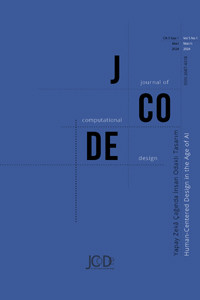Abstract
Yapay zekâ teknolojisindeki gelişmeler, artık sadece iş süreçlerimizi ve üretim yöntemlerimizi değiştirmekle kalmıyor; aynı zamanda yaratıcılık ve tasarım anlayışımızın da yeniden şekillendirilmesine neden oluyor. Bu gelişmeleri grafik tasarım alanı için yeni bir teknolojik sıçrama sürecini başlatmıştır. Grafik tasarım alanında yapay zekâ teknolojisi, özellikle derin öğrenme ve makine öğrenmesi teknolojilerindeki ilerlemelerle birlikte 2010 yılından itibaren otomatik görüntü oluşturma, tasarım önerileri, renk ve düzen optimizasyonu gibi alanlarda kullanılmaya başlanmıştır. Bu kapsamda, yapay zekâ teknolojilerinin grafik tasarım alanıyla etkileşimini, bu alana entegrasyonunu ve tasarım süreçleri ile grafik tasarımcılar üzerindeki olası etkilerini incelemek amacıyla alanlarında uzman ve profesyonel 7 grafik tasarımcının katıldığı vaka çalışması gerçekleştirilmiştir. Yarı yapılandırılmış görüşmeler kapsamında tasarımcılar, bir yapay zekâ aracı olan Dall-e'yi kullanarak verilen briefler doğrultusunda yazdıkları promptlar ile görsel çıktılar üretmiş ve çalışma sırasında oluşturulan görsel çıktıları tasarım kriterlerine göre değerlendirmişlerdir. Çalışma sürecinde, grafik tasarım alanında yapay zekâ uygulamalarının geleceği, olumlu ve olumsuz yönleri, prompt oluşturma pratiğinin elde edilen görsel sonuca etkisi, Dall-e kapsamında oluşturulan görsellerin yeterliliği, gelişen bu teknolojinin gelecekte tasarımcıların rolünü nasıl değiştirebileceği, tasarımcıların yaratıcılık ve özgünlük algıları, tasarımcıların teknik beklentileri ve yapay zekâ kullanımı sırasında karşılaştıkları zorluklar ve olanaklar üzerinde durulmuştur. Bu kapsamda yapılan çalışmalar sonucunda yapay zekâ teknolojilerinin grafik tasarım alanında oldukça verimli bir araç olarak kullanılabileceği sonucuna varılmış ve tasarımcıların bu alanda daha güncel olmaları gerektiği vurgulanarak, grafik tasarım eğitimi veren kurumların da güncellenmesi gerektiği sonucuna varılmıştır.
References
- Baker, S. E., Edwards, R., & Doidge, M. (2012). How many qualitative interviews is enough: Expert voices and early career reflections on sampling and cases in qualitative research.
- Fatima, I. (2023). Designing with AI. Stockholm: User Experience and Interactive Media Technology Södertörns University.
- Franzen, C. (2023). OpenAI Unveils DALL-E 3 with support for text and typography. VentureBeat: https://venturebeat.com/ai/openai- unveils-dall-e-3-with-support-for-text-and-typography/
- Hashemieh, S. (2020). An exploration of the use of Artificial Intelligence in Graphic Design.
- Hien, N. (2023 ). Impact of Artificial Intelligence in design. LAB University of Applied Sciences Bachelor of Business Administration, Business Information Technology , 1-39.
- Jockims, T. L. (2022). Why graphic designers think Generative A.I. Needs Them As Much As They Need It. CNBC: https://www.cnbc.com/2023/08/05/why-graphic-designers- think-gen-ai-needs-them-as-much-as-they-need-it.html
- Kulkarni, C., Druga, S., Chang, M., Fiannaca, A., Cai, C., & Terry, M. (2023). A Word is worth a thousand pictures: Prompts as AI Design material. Conference acronym ’XX,. Woodstock, NY.
- Li, Y. (2020). Innovation and design in the age of Artificial Intelligence. Journal of Product Innovation Management , 37(3).
- Liu, Y. (2023). Design of graphic design assistant system based on Artificial Intelligence. International Journal of Information Technologies and Systems Approach, 13.
- Luis, F. C. (2023). Goan students redefine graphic design with AI technology. Gomantak Times. https://www.gomantaktimes.com/news/goa/goan-students- redefine-graphic-design-with-ai-technology
- Macefield, R. (2009). How to specify the participant group size for usability studies: A practitioner’s guide. Journal of Usability Studies, 5(1), 34–45.
- Malamin, B. (2022). Attitudes of graphic designers and copywriters in Bulgaria towards Artificial Intelligence. Printing-office of Prof. Marin Drinov Publishing House of Bulgarian Academy of Sciences.
- Meron, Y. (2022). Graphic design and Artificial Intelligence: Interdisciplinary challenges for designers in the search for research collaboration. Design Research Society. https://doi.org/10.21606/drs.2022.157
- Mustafa, B. (2023). The impact of Artificial Intelligence on the graphic design industry. Social Science Journal, 1-13.
- Nielsen, J., & Landauer, T. K. (1993, May). A mathematical model of the finding of usability problems. In Proceedings of the INTERACT'93 and CHI'93 Conference on Human Factors in Computing Systems (pp. 206-213).
- Şekerli, T., (2024). Grafik Tasarım Pratiğinde Üretken Yapay Zekânın Etkinliği Üzerine Nitel Bir Araştırma [Unpublished master’s thesis]. Mimar Sinan Fine Arts University, Istanbul, Türkiye.
- Vergant, R., Vendraminelli, L., & Iansiti, M. (2020). Innovation and design in the age of Artificial Intelligence. Journal of Product Innovation Management, 37(3).
Details
| Primary Language | Turkish |
|---|---|
| Subjects | Computer Aided Design in Visual Communication, Machine Learning (Other) |
| Journal Section | Research Article |
| Authors | |
| Early Pub Date | March 29, 2024 |
| Publication Date | March 31, 2024 |
| Submission Date | January 15, 2024 |
| Acceptance Date | March 7, 2024 |
| Published in Issue | Year 2024 Volume: 5 Issue: 1 |


